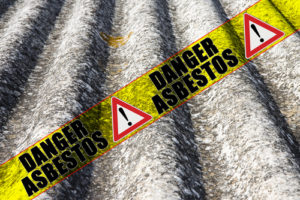January 5, 2018
Asbestos: The Lurking Danger for Construction Workers
By Jonathan Damashek
Posted in

Among the many different possible construction site accidents, workers are at particularly high risk for asbestos exposure since so many of the materials and products they work with contain asbestos. Construction trades especially at risk include the following:
- Drywall workers
- Plasterers
- Roofers
- Plumbers
- Electricians
- Painters
- Floor and tile installers
- Bricklayers
- Stonemasons
- Demolition workers
- Renovation workers, particularly those renovating buildings constructed prior to the 1970s
- Laborers
Insidious Danger
While the use of asbestos has been drastically reduced in the past 40 years, it is estimated that at one time, over 4,000 individual construction products contained asbestos. The Environmental Protection agency says that the vast majority of America’s public and commercial buildings contain asbestos.
As asbestos-containing materials age, many of them start to deteriorate. Others can be damaged through cutting, drilling, scraping, sanding, etc. Asbestos dust fibers can be 1,200 times thinner than a human hair. Due to their incredibly small size and weight, not only do they float in the air for long periods of time, the slightest breeze from outdoor wind or indoor fans can disperse them over wide areas.
While 55 countries have banned asbestos usage in construction materials, it is still legal, albeit highly restricted, in the United States. Consequently, any and all of the following products can contain asbestos:
- Drywall and drywall-related products
- Pipeline wrapping
- Duct tape
- Insulation
- Siding panels
- Joint packing
- Roofing materials such as felts and coatings
- Other types of construction felts
- Textured paints
- Vinyl floor tiles
- Cement materials such as shingles and insulating cements
- Anything containing vermiculite
Alarming Statistics
Perhaps the most frightening aspect of asbestos inhalation is that its effects are not immediately apparent. Symptoms may not appear until years or even decades after the construction worker was exposed to the deadly fibers.
Today, over six million construction and other workers are at high risk for asbestos exposure, with New York being among the top five states employing such construction workers. More than 10,000 people die each year from asbestos-related diseases and 50 percent of work-related cancer deaths are attributed to asbestos exposure. New pleural mesothelioma diagnoses range between 2,000 and 3,000 cases annually, and 80 percent of all types of mesothelioma are caused by asbestos exposure. The direct economic costs of asbestos-related cancers are over $3 billion each year.
Additional Forms of Exposure
Not only can asbestos be breathed into the lungs, it also can be ingested when asbestos fibers in the air fall onto food, beverages, utensils, pots and pans, microwave containers, etc. Cigarettes, cigars, pipes and other smoking materials likewise can accumulate asbestos fibers on their surfaces.
There are three well-documented types of asbestos exposure:
- Occupational exposure by workers during on-the-job activities
- Para-occupational exposure by workers’ families from breathing asbestos fibers released from the worker’s clothing and shoes
- Neighborhood exposure by anyone living or working near an asbestos-related project from breathing dispersed asbestos fibers
Asbestos Exposure Lawsuits
Bringing an asbestos exposure lawsuit is a very complicated undertaking. FindLaw explains that an asbestos lawsuit usually is a form of product liability suit brought against the manufacturer, distributor and/or seller of the product that caused the plaintiff’s illness and/or condition. Generally, the suit is based on one of three legal theories:
- Breach of warranty
- Negligence
- Strict liability
In both negligence and strict liability cases, the plaintiff must prove causation; i.e., that use of and/or exposure to the product caused the plaintiff’s illness. Proving causation can be particularly difficult in an asbestos exposure suit where the plaintiff may not have been diagnosed with an asbestos-related illness for as long as 50 years after the exposure took place.
If the plaintiff can prove causation and the other elements of a negligence or strict liability case, however, settlements and jury verdicts usually are quite substantial and could include monetary damages for any and all of the following things:
- Cost of medical care, both past and future
- Cost of any necessary rehabilitation
- Lost earning capacity
- Lost wages, both past and future
- Lost enjoyment of life
- Emotional and psychological distress
- Pain and suffering, both past and future
Occasionally a successful plaintiff also may be awarded punitive damages, although these awards are relatively rare. Punitive damages are reserved for cases where the defendant’s conduct was especially egregious and consequently deserves to be punished.